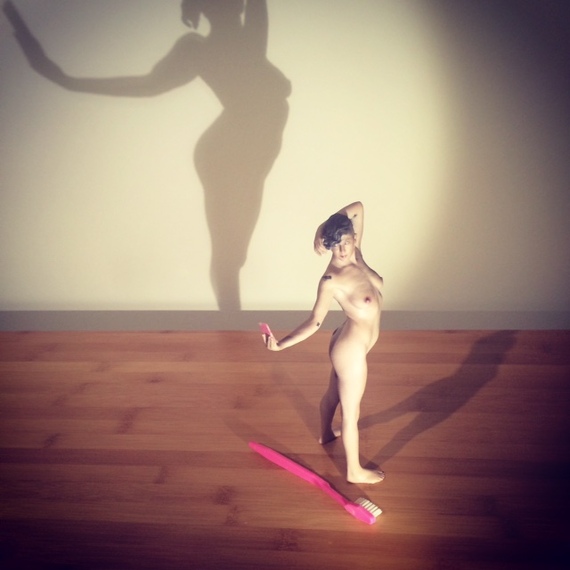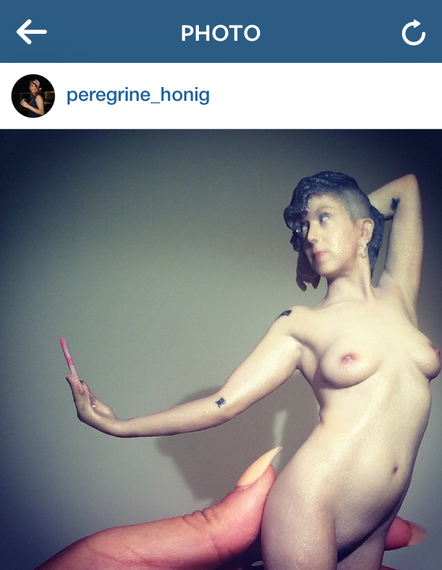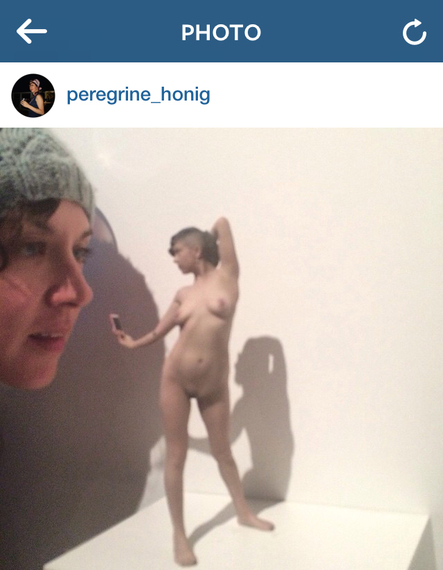The Homunculus of Libido
Down through art history, a special status has attached to the self-portrait. It is the artist's response to the Delphic injunction, "Know thyself." In the self-portrait, the artist is, perhaps romantically, expected to display his or her most profound understanding of psychology, wisdom, hope, and despair.
The proliferation of digital cameras, either aimed at mirrors or with the lens pointed backward, has recently overlaid the "selfie" on this antique genre. Just as "selfie" is a degenerate form of the term "self-portrait," so the selfie itself strikes me as a degenerate form of the genre, an inversion of every responsibility and aspiration pinned to the self-portrait. The self-portrait demands more insight than other pictures; the selfie none at all. The point of the self-portrait is disclosure of the element of self which cannot, quite, be seen - of the soul. It is aligned with the memento mori still life in reconciling life with the hard fact of mortality. The point of the selfie is teh hawtness - eternal youth. The dignified emotions of humility or its friend, fierce pride, animate the self-portrait. The selfie is nothing if not vain.
And yet, all orphaned aspirations, all botches and follies, will quietly make their way home to the broad arms of art, and so too, prolific and whimsical Kansas City artist Peregrine Honig has welcomed the selfie back into the fold. She has generated several selfie-themed pieces, of which I would like to discuss #textme with you today.

#textme, screen-grab from Instagram, from an account that was suspended over this work; you can re-follow Peregrine Honig at @peregrinehonig
This is a 3D-printed 1/8th-scale sandstone sculpture of Honig, printed in color and eventually placed under glass. I first saw it on Instagram, a forum fairly well-established as a sinkhole of exhibitionism. Let me cop to something here. I have a background-noise interest in what all the attractive women I know look like naked, and I pretty much think of all the women I know as attractive. I think this background noise is audible to most straight guys. The hawtness selfie, in this sense, is tailor-made to tease or gratify our prurient interests. So when this image scrolled by in my Instagram feed, I was like, "Holy crap, I don't know what she's up to this time, but that is a very naked Peregrine Honig." Then I looked slightly more closely, and it was as if the picture stung me. It wasn't her after all. It was a creepy simulacrum. It was obviously 3D-printed, and so there was every chance that you could say I now knew what Peregrine Honig looked like naked. But I did not. I knew what a synthetic analogue of her body looked like.
In fact, it produced an effect similar to those mishaps where you hold a lighter some distance in front of an active can of bugspray to make a flame thrower, but the fire travels back up the spray to the can, causing it to blow up in your hand. The mechanical quality of the reproduction meant that no human hand had intervened in its synthesis. It was unparsed by consciousness, and this lack of parsing was what prevented it from being truly naked. But all selfies are essentially things made by machines, aren't they? The poses, compositions, subjects strictly limited, and the overriding phenomenon the tiny lens of the iPhone or the Galaxy. If Honig's selfie does not tell us what she looks like naked, no selfie does; her piece back-contaminates the entire field.
This is very interesting, and it led me to consider the sculpture more closely.
Its semiotic density began to come into focus. It was such a simple thing, but it contained so much.
Its nearly revolting realism places it squarely into the uncanny valley - the region where a replica of a human being is too much like what it mimics, but not enough to be convincing. Honig's sculpture doesn't have the imperfect hyperrealism of the Ron Mueck sculptures it most resembles - those bear the imperfections of their manual creation. Honig's sculpture, in contrast, is perfect, but its mode of perfection is slightly different from what human beings are like.
Its realism invokes the theme of the double, the doppelgänger. This is the double whose existence promises immortality, but whose very perfection raises the specter of replacement, so that in the end, the doppelgänger becomes the harbinger of death. If you were to meet your doppelgänger, you would shortly die. The doppelgänger is understood to be a member of the school of the uncanny.
Honig's doppelgänger is of a special type - the little man, the gnome, the homunculus. There is a dreadful quality to creatures at this altered scale, acknowledged throughout folklore as things under bridges, slippers-in to homes, thieves, murderers, abductors. Inside of your house there is a tiny house, and inside this house there is a tiny you...
The upfront sexuality of Honig's take on the theme foregrounds another problem of the homunculus, the ambivalence of sexual attraction to individuals of the wrong scale. Call it the Tinkerbell dilemma. One might entertain lustful thoughts about this mini-her, as one might about a 50-foot giantess, but to actually follow through would be an invitation to disaster. Therefore the thought itself induces queasiness.
Honig has produced a phantasmagorical analogue to the standard selfie at every step of the way. Consider how her line of flame burns backward to its inspiration: like #textme, the selfie is no image of the self, as the self-portrait is. Like #textme, the selfie's pictorial validity depends on the camera's promise of optical perfection. Like #textme, the selfie is a double, anchored in mechanical likeness. Like the doppelgänger, the selfie tends to drain the life from its maker, replacing human interaction with a rude addiction to "likes." And the selfie is a homunculus, attended on at reduced scale through the screen of a telephone or a computer, where its overclocked sexuality beckons as feverishly as it neurotically recedes.
And finally, let us consider the jar Honig placed it in.
This is her coup de grâce. It is the display case of a doll. Honig finds a visual metaphor here for the manner of presentation of self, desire, and sexuality endemic to the selfie. She has already literally and metaphorically objectified herself, but the jar lends a really distressing mode to the objectification. The roar of her humanity is muted behind the bell jar of a toy. It is reduced and neutered, made odorless and pretty and safe. Honig detaches her own sexuality here and showcases it like a specimen. This too is in the nature of the selfie.
Honig accomplishes all these things with wit and economy of means. In one surprisingly dense artifact, she makes art in the visual paradigm, producing a riveting image, and she makes art in the conceptual paradigm: her art object, generated mechanistically as the clever output and expression of its concepts, replaces the floating thoughtlessness of the selfie with its contextualization in terms of Western civilization's eccentric history of representations and mythologies of the self.
--
#textme and its companion sculpture, #showme, will be on display as part of a group show at Haw/Contemporary Gallery from 12/12/14 through 1/24/15
Address: 1600 Liberty, Kansas City, MO 64102
Telephone: 816.842.5877
Hours: Tuesday through Friday 9-5, Saturday 12-5
http://www.hawcontemporary.com/




